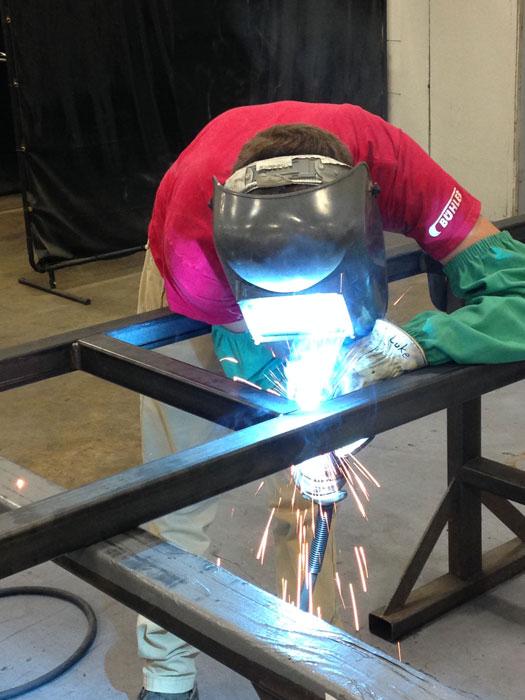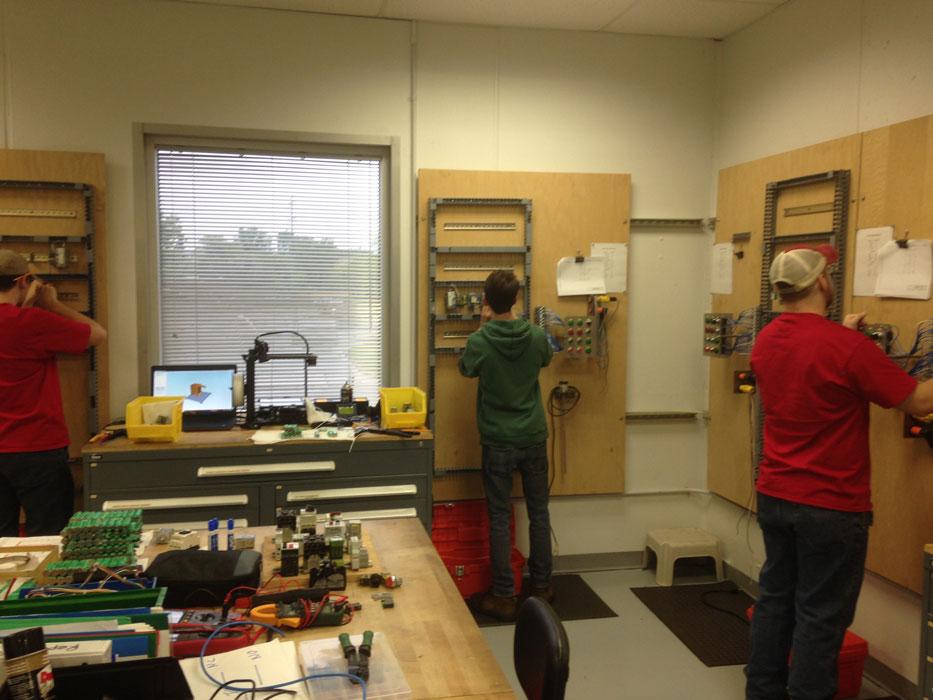Editor-in-Chief
- FMA
- The Fabricator
- FABTECH
- Canadian Metalworking
Categories
- Additive Manufacturing
- Aluminum Welding
- Arc Welding
- Assembly and Joining
- Automation and Robotics
- Bending and Forming
- Consumables
- Cutting and Weld Prep
- Electric Vehicles
- En Español
- Finishing
- Hydroforming
- Laser Cutting
- Laser Welding
- Machining
- Manufacturing Software
- Materials Handling
- Metals/Materials
- Oxyfuel Cutting
- Plasma Cutting
- Power Tools
- Punching and Other Holemaking
- Roll Forming
- Safety
- Sawing
- Shearing
- Shop Management
- Testing and Measuring
- Tube and Pipe Fabrication
- Tube and Pipe Production
- Waterjet Cutting
Industry Directory
Webcasts
Podcasts
FAB 40
Advertise
Subscribe
Account Login
Search
Solving the skills gap one class at a time
Bühler Aeroglide welcomes the first graduates of its apprenticeship program
- By Dan Davis
- Updated July 11, 2023
- December 28, 2018
- Article
- Shop Management

Figure 1
(From left to right) Apprentices Alex Gaither, Mason Hurlbut, Luke Fouts, and Simon Mitchell pose with Michael Taylor, Bühler Aeroglide’s apprenticeship manager; Dylan Beckwith, an apprentice with Schunk; and Ruben Heinz, Schunk’s head mentor, at the recent apprenticeship graduation ceremony. Bühler Aeroglide and Schunk are two of the participating employers in the North Carolina Triangle Apprenticeship Program.
Some fabricating companies frequently talk about a lack of candidates for skilled manufacturing jobs in their facilities. Others have forgone the woeful tales and taken action.
Several manufacturing companies around Raleigh, N.C., did the latter when they came together to found the North Carolina Triangle Apprenticeship Program (NCTAP) in 2013. They wanted to create an apprenticeship program that was modeled after a similar one in western North Carolina. The manufacturers, which included Bühler Aeroglide, a maker of drying machines and other thermal processing equipment for food and feed processors and other industrial applications, would provide on-the-job training for prospective candidates, and Wake Technical Community College in Raleigh would handle the classroom training once those candidates graduated from high school.
After the humble start, interest in the program has started to grow, particularly as students start to see the advantage of getting paid to learn as opposed to paying a four-year learning institution for the privilege of pursuing a degree that may not guarantee a job. Additionally, the manufacturers that once found schools reluctant to open their doors so that they could share their message about on-the-job learning now find these school leaders and guidance counselors to be big supporters of NCTAP.
Bühler Aeroglide, Cary, N.C., graduated its first class of apprentices in August 2018 (see Figure 1). Michael Taylor, who has been with the company for 17 years and is now involved in managing the apprenticeship program, spoke with The FABRICATOR about this first class of graduates, how the apprenticeship program is working out for his company, and what the plans are for the future.
The FABRICATOR: How did you get involved with the apprenticeship program?
Michael Taylor: I’ve been involved with setting the program since January 2014. I’ve also been on the board of NCTAP, so I’ve been a very involved guy.
Prior to this I was involved with outsourcing project management. I was off-site for six years with a vendor of ours and oversaw them building our equipment to ensure that the quality levels were maintained to our standards. I also would work with the engineers and designers if there were problems.
One day I just got a phone call from my human resources director at the time, and he asked if I would be interested in this job. I guess they just felt like I had the right personality to work with the kids. And so we went from there.
FAB: Do you have other responsibilities besides the apprenticeship program?
Taylor: I’m also the manufacturing logistics trainer. My main position is really the apprenticeship leader, but manufacturing logistics was included because at first it was thought that this wasn’t going to be a full-time job.

Figure 2
The apprenticeship program at Bühler Aeroglide is registered with the state of North Carolina as one focusing on assembly and welding. Most of the apprentices’ time is spent in these areas, but the company also rotates them through other parts of the company in an attempt to groom more well-rounded employees.
But it makes sense because I do the training here. I do the forklift driving certification, overhead crane training, and blueprint reading classes. It helps me because I can integrate the apprentices into that as well.
FAB: After graduating from the Bühler Aeroglide apprenticeship program, what did these students end up with?
Taylor: When they finished the program, they graduated with their two-year degree from Wake Technical Community College in mechanical engineering technology. The degree covers design-type work, machine operations, manufacturing processes, and even 3-D printing. They also get a journeyman’s certificate from the state of North Carolina and a certificate from the U.S. Labor Department as well.
And then of course they are guaranteed a job with a minimum base salary. So all the companies involved in the program generally have the same rate.
There is a salary range over that four-year apprenticeship, and the reason for that is so we can use it as motivation. For example, if they have bad attendance, such as showing up late, I actually can take money away from them as long as it’s within that pay range. Of course, it also gives them incentives to work hard because they can hit the top of the pay range as well each year.
FAB: How did these apprentices become a part of the program?
Taylor: In their junior year, they apply for this program, and when they start their senior year, they start the apprenticeship. They go to high school half of the day, and they work the other half of the day. As soon as they graduate, they’re brought on full time. So they get 100 percent, full-time benefits.
They are almost like a normal employee. The big difference is that they go to school one day a week at Wake Technical Community College, and they work four days a week. They are paid to go to school.
FAB: Do you have to recruit a new class of apprentices every year?
Taylor: We typically have an apprenticeship budget each year for my company, but I will tell you there’s been some years I took only one. But there have been other years where I took more. This past year I just took in four.

Figure 3
The Bühler Aeroglide apprentices had the chance to visit a sister facility in Minnesota for two weeks, where they had the chance to learn basic electrical safety and control panel wiring.
Bühler is a Swiss company, and it is supportive of apprentices. That’s just the way of life over there. The company actually has 170 apprentices on-site in Switzerland at the main headquarters.
FAB: So you’ve had some success with keeping students as part of the apprenticeship program once they start, correct?
Taylor: I’ve actually lost only three in the four years I’ve done this. One wanted to pursue a music career with her parents’ support, so what could I say at that point? I had another one that changed his major to business because he wanted to eventually work in his parents’ company, but that major didn’t fit into the parameters of the associate degree that we have set up. That particular young man actually moved into an interim position, basically. The third one I lost because he wanted to learn more about automation.
FAB: What about your four recent apprenticeship graduates? What are they doing now?
Taylor: They are all full-time employees and doing really well.
One of them was in the Netherlands in October for an international conference on leadership. He was chosen out of Bühler Group’s North American workforce. He’s involved in procurement and purchasing right now.
I’ve got one that’s almost fully involved in welding (see Figure 2), doing really well. I’ve got another one that’s in production, where he is involved in routing all of the blueprints and the specs for jobs. I have another one who is working in customer service and doing some design work.
They also were put into these positions because we’re about to integrate SAP software into the company. Management wanted them to participate because they’re very smart and very good employees.
FAB: It’s interesting to see the apprentices doing all sorts of different jobs. Is the apprenticeship set up to offer them exposure to these roles?
Taylor: It is, but the apprenticeship path at our company is registered with the state as “welding and assembly.” But the deal is we rotate these kids from department to department. The only thing that the path means is they have to spend more time in that one particular area during their apprenticeship. But our philosophy on this is we want well-rounded employees (see Figure 3). Our human resources director, Krystal Anderson, and I have worked to create individual development plans for each of these apprentices.
These young people are going to be our future. We want them to understand how production control works. We want them to understand how design and engineering work. We want them to learn about shipping and inventory. We want these kids to know as much about the company as they possibly can.
So when they come out of the program, even though their path may have been for welding and assembly, if they excelled in an area and did well, we keep an eye on that. We do what we call an individual development plan. Usually going into their third year, we’ll start working on it. We have routine meetings with them to try to figure out where we’re going to place them when they graduate. This obviously helps us too because we have to absorb these apprentices somewhere in the company, which is not a problem, but we want to plan for what they’re going to be doing.
FAB: As these apprentices become better at their job, do they have the opportunity to work overtime?
Taylor: They do, but I also regulate that and watch it carefully. I want to make sure that they are keeping up with their school work. If they are in their third or fourth year and they’ve done well in school, I don’t think it’s a problem.
Again, that decision is controlled by me. Somebody has got to be an advocate and make sure that kids aren’t working all the time and not learning.
FAB: Do you think this apprenticeship program is making a difference at Bühler Aeroglide?
Taylor: Absolutely. These kids are productive almost immediately. So it really helps the company a lot. For example, we’ve had people go on sick leave for various reasons, and an apprentice actually has been able to step in and fill their shoes for a temporary amount of time because he has already worked in that area and has learned how to run the equipment.
They also have had positive impacts in other ways. In their positions, they really get to see and understand a lot more about the company than others. For example, when things are changed on the floor, a lot of people are thinking “Why did they do that?” These kids have the opportunity sometimes to understand it better because they see the whole picture a lot more clearly.
FAB: Can you scale this apprenticeship program so that it can grow with the company?
Taylor: It can grow, and we want it to grow.
Anderson and I would like to open up another track that is based more on the office side of things. So if we do that, the apprentices are still going to come in, start on the floor, and do the same rotation that the other apprentices are already doing. I’ll just shorten their time in other departments and then they’ll filter into the front office.
And the same thing goes in reverse for my kids on the floor. We want them to be involved in all this stuff as well. But we would like to cater a little bit more to the office stuff and open up another track and maybe try to go with a more general education-type curriculum instead of including manufacturing in it. That’s for multiple reasons. One, we like these young, fresh minds coming in; we can teach them what we want them to know. It also would help out with recruiting more diverse apprenticeship applicants. It can be hard to attract the attention of females into considering a career path in manufacturing.
FAB: How often are you in schools recruiting?
Taylor: There’s one time a year when we make a pretty big push, when we go out and actually talk to the students in the schools. That’s usually in the fall, from October to the beginning of December.
I’m also involved with three business alliances that are affiliated with three local schools. I’m actually chairman on one of those business alliances. From being a part of these groups, I’ve learned that we need to get these schools to buy in and understand that there are career options in manufacturing that don’t necessarily involve the traditional four-year college route. The belief that you need to go to a four-year college has been very hard to break.
So we go into the schools, volunteer our time, help out, and help the students. We also get to talk to the CDCs, which are the career development coordinators. You can explain the program to them. I’ve even invited them out to our facility to see the program up close. After they come out for tours, they start realizing that there are other opportunities there than just pushing this four-year college agenda all the time.
FAB: Looking back, what’s your take on your involvement in the apprenticeship program?
Taylor: From a personal perspective, it’s the best job in the world. I mean, I love making things. That’s something that’s always intrigued me, but to be able to say that you’ve helped a young adult get a start in life, that is pretty gratifying.
I will tell you that I’ve thought about this more frequently now that I’ve had my first graduating class. Did I do right by them? Did I teach them right?
But even wondering about that, I feel that it’s been very rewarding. It’s great. One apprentice is now moving out of his family’s house. Another one just bought his first brand-new vehicle.
These young adults have actually saved their money during their apprenticeship. Now they don’t have school debt.
So, overall, I didn’t know what to anticipate when I first got involved. It’s turned out to be one of those once-in-a-lifetime opportunities for me.
FAB: What type of support enables you to be successful in this role?
Taylor: You definitely have to have a company that believes in it and understands what it takes. So the company has to back you up on it. I feel very strongly about that.
You really need to have somebody that’s in that position full time. If the apprentices are working in a department and learning somewhere else, I walk around and check on them every day, seeing what’s going on with them. You have to be able to create that bond there to be successful.
It’s important for the company to stick it out and stay committed to seeing the full results of the apprenticeship program, because not everybody in the company understands that. Workers may see someone filling in for somebody who’s out, but they don’t understand that the replacement is productive because he was an apprentice. As time goes on, everyone starts to learn that, and the word spreads throughout the company.
Photos courtesy of Michael Taylor, Bühler
About the Author

Dan Davis
2135 Point Blvd.
Elgin, IL 60123
815-227-8281
Dan Davis is editor-in-chief of The Fabricator, the industry's most widely circulated metal fabricating magazine, and its sister publications, The Tube & Pipe Journal and The Welder. He has been with the publications since April 2002.
subscribe now

The Fabricator is North America's leading magazine for the metal forming and fabricating industry. The magazine delivers the news, technical articles, and case histories that enable fabricators to do their jobs more efficiently. The Fabricator has served the industry since 1970.
start your free subscription- Stay connected from anywhere

Easily access valuable industry resources now with full access to the digital edition of The Fabricator.

Easily access valuable industry resources now with full access to the digital edition of The Welder.

Easily access valuable industry resources now with full access to the digital edition of The Tube and Pipe Journal.
- Podcasting
- Podcast:
- The Fabricator Podcast
- Published:
- 04/30/2024
- Running Time:
- 53:00
Seth Feldman of Iowa-based Wertzbaugher Services joins The Fabricator Podcast to offer his take as a Gen Zer...
- Industry Events
Pipe and Tube Conference
- May 21 - 22, 2024
- Omaha, NE
World-Class Roll Forming Workshop
- June 5 - 6, 2024
- Louisville, KY
Advanced Laser Application Workshop
- June 25 - 27, 2024
- Novi, MI
Precision Press Brake Certificate Course
- July 31 - August 1, 2024
- Elgin,































